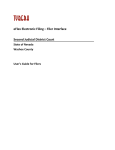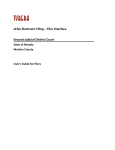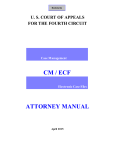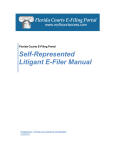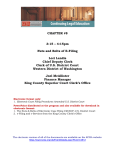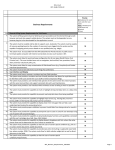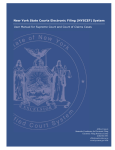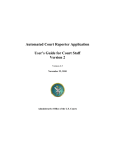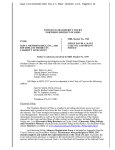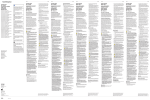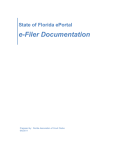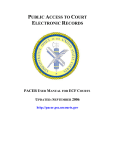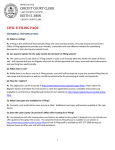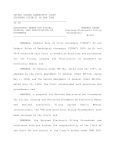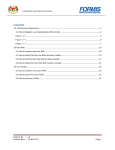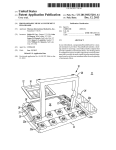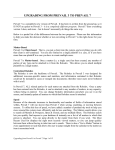Download User`s Guide for Filers - eFiling
Transcript
eFlex Electronic Filing – Filer Interface User’s Guide for Filers Cobb County Magistrate Court Electronic Filing September 2014 2 – Filer Interface User’s Guide Introducing e-Filing ............................................................................................................................7 e-Filing Basics ............................................................................................................................................ 7 Figure 1: eFlex Navigation ................................................................................................................. 7 Figure 2: eFlex Breadcrumb Trail ...................................................................................................... 8 Document Preparation Prior to Login ....................................................................................................... 8 Getting Started ..................................................................................................................................8 Logging In and Requesting an Account ..................................................................................................... 8 Figure 3: Login Screen ....................................................................................................................... 9 Figure 4: Reading and Accepting User Agreement ......................................................................... 10 Figure 5: New Filing Option for Pro Se Users .................................................................................. 10 Figure 6: Selecting “Accept” and Clicking “Submit”........................................................................ 11 Figure 7: Association with a User Role ............................................................................................ 11 Figure 8: Association with an Organization .................................................................................... 11 Figure 9: Creating a New Organization ........................................................................................... 12 Figure 10: Using Profile Information ............................................................................................... 12 Figure 11: Notification of User Account Request ........................................................................... 14 Resetting Forgotten Password ................................................................................................................ 14 Figure 12: Requesting a Password Reset ........................................................................................ 15 Figure 13: Temporary Password Sent to Your Email....................................................................... 15 Figure 14: Temporary Password for One-Time Login ..................................................................... 16 Figure 15: Resetting a Forgotten Password .................................................................................... 16 Navigating from the Home Page ............................................................................................................. 17 Figure 16: Home Page ..................................................................................................................... 17 Logging Out ............................................................................................................................................. 17 Figure 17: Notification of Drafts (or Incomplete Filings) ................................................................ 18 Working with Profiles.......................................................................................................................18 My User Profile ....................................................................................................................................... 18 Viewing or Editing Your User Profile ................................................................................................... 18 Figure 18: My User Profile .............................................................................................................. 19 Figure 19: User Profile..................................................................................................................... 19 Figure 20: Modify User Profile ........................................................................................................ 20 2 Copyright, September 2014 – Tybera Development Group, Inc. NOT FOR DISTRIBUTION Filer Interface User’s Guide - 3 Figure 21: Email Notification Settings ............................................................................................. 21 Passwords ............................................................................................................................................... 21 Changing the Password ....................................................................................................................... 21 Figure 22: Change Password Screen ............................................................................................... 22 Login History ........................................................................................................................................... 22 Viewing Login History.......................................................................................................................... 22 Figure 23: Login History .................................................................................................................. 23 Working with Cases..........................................................................................................................23 To View My Cases ................................................................................................................................... 24 Figure 24: List of “My Cases” .......................................................................................................... 24 To Navigate My Cases Page ................................................................................................................ 25 Figure 25: Filters Controlling Page View ......................................................................................... 25 Figure 26: Viewing the Case History ............................................................................................... 25 Figure 27: Case History Page ........................................................................................................... 26 Figure 28: Search Cases................................................................................................................... 27 Figure 29: Case Sorting ................................................................................................................... 28 Figure 30: List of “My Cases” .......................................................................................................... 28 Figure 31: “Inactive” Checkbox ....................................................................................................... 29 Figure 32: Search Cases................................................................................................................... 29 Viewing Case History........................................................................................................................... 30 Figure 33: Case History View .......................................................................................................... 30 Viewing Certificate of Service ............................................................................................................. 31 Figure 34: Certificate of Service ...................................................................................................... 31 Notifications ............................................................................................................................................ 32 Figure 35: Notice of Electronic Filing (NEF)..................................................................................... 33 Figure 36: Accessing Notifications .................................................................................................. 34 Figure 37 List of Notifications ......................................................................................................... 34 Figure 38: Viewing Service List and Document ............................................................................... 35 Figure 39: Deleting Notifications .................................................................................................... 35 Viewing Filing Charges ............................................................................................................................ 36 3 NOT FOR DISTRIBUTION Copyright, September 2014 – Tybera Development Group, Inc. 4 – Filer Interface User’s Guide Figure 40: Calculated Fees from the Review and Approve Page .................................................... 36 Viewing Filing Charges ........................................................................................................................ 37 Figure 41: List of Filing Charges ...................................................................................................... 37 Working with eFile ...........................................................................................................................37 Initiating a New Case .............................................................................................................................. 38 Figure 42: Initiating a New Case...................................................................................................... 38 Figure 43: Selecting the Court......................................................................................................... 39 Figure 44: Case Category Page ........................................................................................................ 39 Figure 45: Case Initiation Page ........................................................................................................ 39 Adding Case Data ................................................................................................................................ 39 Figure 46: Creating the Submission on the Case Initiation Page .................................................... 40 Adding a Party to the Case .................................................................................................................. 40 Figure 47: Adding Parties ................................................................................................................ 40 Figure 48: Add My Party Information Page..................................................................................... 41 Figure 49: Required Fields............................................................................................................... 41 Figure 50: Parties to Be Served Added Individually ........................................................................ 42 Figure 51: Attorney Section ............................................................................................................ 42 Figure 52: Adding Alias on Additional Business Name .................................................................. 43 Figure 53: Case Initiation Displays Plaintiff Added ......................................................................... 43 Figure 54: Adding Defendant Information ...................................................................................... 44 Figure 55: Case Initiation Page Displaying Both Parties.................................................................. 44 Adding Documents on a New Case ..................................................................................................... 45 Figure 56: Add a Document Page.................................................................................................... 45 Figure 57: Document Category Drop-down .................................................................................... 45 Figure 58: Document Type Drop-down........................................................................................... 46 Figure 59: Setting Document Security Level to Sealed ................................................................... 46 Figure 60: Additional Text ............................................................................................................... 47 Figure 61: Locating Your Document................................................................................................ 47 Figure 62: Adding a Document ....................................................................................................... 47 Figure 63: Document Added ........................................................................................................... 47 Figure 64: Incorrect Document File Format .................................................................................... 48 4 Copyright, September 2014 – Tybera Development Group, Inc. NOT FOR DISTRIBUTION Filer Interface User’s Guide - 5 Figure 65: List of Added Documents ............................................................................................... 48 Figure 66: Accessing Draft Filings.................................................................................................... 49 Submitting the Initial Filing ................................................................................................................. 49 Figure 67: Fee Payment Requirement for Filing ............................................................................. 50 Figure 68: Changing Filing Information ........................................................................................... 51 Figure 69: Adding or Removing Documents ................................................................................... 51 Figure 70: Moving Filing to Drafts ................................................................................................... 51 Figure 71: Filing Submitted Message .............................................................................................. 52 Figure 72: Filing Status .................................................................................................................... 52 To View or Print Documents Associated With a Case......................................................................... 52 Figure 73: My Filings Page Displays Filings with Links for Additional Information ......................... 53 Figure 74: Filing Status Page ........................................................................................................... 53 Figure 75: Viewing Documents from the Filing Status Page ........................................................... 54 Figure 76: Viewing Court Time/Date Stamp Documents from the Filing Status Page.................... 55 Figure 77: Court Time/Date Stamp ................................................................................................. 55 Figure 78: Court Generated Receipt ............................................................................................... 56 eFiling to An Existing Case....................................................................................................................... 56 Adding a Document to an Existing Case ............................................................................................. 56 Figure 79: Existing Cases ................................................................................................................ 57 Figure 80: Searching For an Existing Case ....................................................................................... 57 Figure 81: Yellow Banner on Existing Case Add a Document Page................................................. 58 Figure 82: Locating Your Document................................................................................................ 59 Figure 83: Incorrect Document File Format .................................................................................... 59 Figure 84: List of Added Documents ............................................................................................... 60 Submitting the Existing Case Filing ..................................................................................................... 60 Figure 85: Adding or Removing Documents ................................................................................... 61 Figure 86: Moving Filing to Drafts ................................................................................................... 61 Understanding Filing Status .................................................................................................................... 62 Figure 87: Check Filing Status on My Filings Page .......................................................................... 63 To check the status of your submissions: ........................................................................................... 63 5 NOT FOR DISTRIBUTION Copyright, September 2014 – Tybera Development Group, Inc. 6 – Filer Interface User’s Guide Figure 88: Selecting Start and End Dates ........................................................................................ 64 Figure 89: Displaying Document Associated with Filing ................................................................. 64 Figure 90: Displaying Additional Details of a Filing ......................................................................... 65 Figure 91: Filing Status Page ........................................................................................................... 66 Handling a “Rejected” Status .............................................................................................................. 67 Figure 92: Resubmit Button for a Rejected Filing ........................................................................... 67 Draft Submissions ................................................................................................................................... 68 Working On a Draft Filing.................................................................................................................... 68 Figure 93: Draft Filing Navigation from Menu Bar .......................................................................... 68 Figure 94: List of Draft Filings.......................................................................................................... 69 Figure 95: “Add a Document” Page ................................................................................................ 69 Deleting a Draft Filing ......................................................................................................................... 69 Figure 96: Deleting a Draft Filing .................................................................................................... 70 Figure 97: Incomplete Filing ............................................................................................................ 70 Appendix A: Creating a PDF and Other Document Display Information ..............................................71 PDF Basics ............................................................................................................................................... 71 Creating Documents ............................................................................................................................... 71 Including Paper Exhibits .......................................................................................................................... 72 6 Copyright, September 2014 – Tybera Development Group, Inc. NOT FOR DISTRIBUTION Filer Interface User’s Guide - 7 Introducing e-Filing e-Filing Basics The Cobb County Magistrate Court e-Filing system is designed to make the work associated with initiating and processing a case more efficient for both filers and court personnel. For the initial phase, the web-based filer interface part of the software allows attorneys and registered filers (Pro Se) to create documents and submit them to the court electronically. The filer interface also provides the means for users to view case histories, check the status of submissions, send follow-up documents, and access service lists. Additionally, the eFlex system is a jumping off point that directs the filer to a court system that allows filers to view documents associated with their cases. For court personnel, the software routes the filings to the appropriate personnel for review, response, generation of additional documents, or further action. For most integrations, when documents are filed in hard copy, once the court personnel scan the documents, the filer interface distributes a courtesy notice to electronic participants on the case so those participants may access the documents electronically. This user’s guide is intended to instruct filers on the features of the eFlex system. Check the Cobb County Magistrate Court eFiling login page for eFiling instructional opportunities. In order to progress through eFiling a case with the greatest ease, following the steps outlined in this manual is highly recommended, including document preparation as discussed below. Also, for best results, users are strongly encouraged to use only the navigation buttons that are displayed on the eFiling interface. These will appear at the bottom of each page and will give the user options such as Back or Next. Figure 1: eFlex Navigation Additionally, the filer may use the menu bar located at the top of each page, just below the Cobb County Magistrate Court banner. Another navigation option is the breadcrumb trail at the top of every page. This appears just below the menu bar, and the active links show the pages the user has visited to get to the current page. Clicking on any of these links will take the user back to the page listed. 7 NOT FOR DISTRIBUTION Copyright, September 2014 – Tybera Development Group, Inc. 8 – Filer Interface User’s Guide Figure 2: eFlex Breadcrumb Trail It is important to avoid using the internet browser back arrow during the preparation and submission of a filing. Document Preparation Prior to Login For most types of cases, the filer will need to attach documents with the initial filing. Generally, those documents and any additional documents that are submitted at a later time need to be submitted as an Adobe® Acrobat® PDF file (Portable Document Format). There are some documents, such as proposed orders that are exceptions to this rule and may be submitted as Microsoft® Word 2003 or higher (.doc or .docx). It is best to be prepared before logging into Cobb County Magistrate Court’s filer interface. The requirement for submitting documents in PDF files also applies to paper exhibits such as copies of contracts or copies of cancelled checks. Such paper exhibits must be scanned and saved as a PDF. Because color scans add to the file size, it is highly recommended that black and white settings be used with a lower resolution setting of 300 dpi (dots per inch) when scanning paper exhibits, unless the loss of the color degrades the value of the evidence. If you need instruction on creating a PDF file, please refer to Appendix A at the end of this user guide. Note: Individual document size is limited to 10 MB. Multiple documents can be included in a single submission. The size limitation for an entire submission is 30 MB. If the document is larger than the 10 MB limit, it will be necessary to split the document into a set of smaller files. When the large documents are split into parts, it is helpful to save the individual parts with file names such as “Part 2 of Motion,” “Part 3 of Motion,” etc. Preparing large documents in this manner prior to beginning the case initiation will save time. Getting Started Logging In and Requesting an Account To begin e-Filing, if you do not already have an efiling account, you must first go to the “Login” page located at: xxxx.xxxx.org and request an account. 8 Copyright, September 2014 – Tybera Development Group, Inc. NOT FOR DISTRIBUTION Filer Interface User’s Guide - 9 The “Login” page is also the place where, periodically, the system administrator may communicate with filers by posting a message providing links to rules or forms or by posting a message notifying users of upcoming system maintenance that will make the system unavailable for a set time period. Figure 3: Login Screen 1. To log into the Cobb County Magistrate Court e-Filing system, simply enter your user name and password. 2. If you do not have a login and password, you will need to first register and create an account. To begin the registration process, click on the Request Account button on the login page. The “User Agreement” page will open. 9 NOT FOR DISTRIBUTION Copyright, September 2014 – Tybera Development Group, Inc. 10 – Filer Interface User’s Guide Figure 4: Reading and Accepting User Agreement 3. Optional: If you are a Pro Se filer (representing yourself) and need to initiate a case, use the Wizard button at the top right of the login box to begin the Request Account process. The routing initiated by use of the Wizard button will create the user account and auto-route the user to the initial wizard enabling the user to begin creating a new case. Follow the directions below to create the user profile. Further instructions, on filing a new case, will be included in the Case Initiation section of this document. Figure 5: New Filing Option for Pro Se Users 10 Copyright, September 2014 – Tybera Development Group, Inc. NOT FOR DISTRIBUTION Filer Interface User’s Guide - 11 4. From the User Agreement page and after reading the terms of agreement, accept the terms by selecting the proper radio button, and click Submit. The “User Roles” page will appear. Figure 6: Selecting “Accept” and Clicking “Submit” Figure 7: Association with a User Role 5. Each eFlex user must have an assigned role. The roles displayed for the Cobb County Magistrate Court eFlex system are that of Agency, Attorney, Financial Administrator, and Pro Se (Selfrepresented Litigant). Select the appropriate user role by clicking in the radio button. 6. Click Next. For every role except that of Pro Se, the “Select a Company” page will open. (For users selecting the Pro Se role, the Request User Account user profile page will display.) Figure 8: Association with an Organization 11 NOT FOR DISTRIBUTION Copyright, September 2014 – Tybera Development Group, Inc. 12 – Filer Interface User’s Guide 7. Each user must be associated with an organization. On the “Select a Company” page, use the drop-down menu to select a company that is already a part of the eFlex community. Alternately, to create a new organization account, select “New,” and fill in the textbox with the company name for which an account is being established. Make sure you use the legal name of the company. Note: If you selected “Pro Se,” you will not be asked to select or enter your organization’s name. You will be taken to a Profile page where you enter your personal information. Pro Se filers are automatically associated as a group to an organization labeled “Pro Se.” Figure 9: Creating a New Organization 8. Click Submit. The “Request a User Account” page will display. Figure 10: Using Profile Information 12 Copyright, September 2014 – Tybera Development Group, Inc. NOT FOR DISTRIBUTION Filer Interface User’s Guide - 13 9. Fill in the textboxes with the appropriate information. Fields marked with an asterisk (*) are required. 10. The user name must be unique. If the user enters a name that is already in use, he or she will be asked to select a different user name. This might be accomplished through addition of a number or with the addition of a middle initial if the user is entering his or her own name as a user name. 11. Depending upon the requirements of the court, your password may contain a specific number of characters with stipulations to include numbers or special symbols. Also, you may be required to have a combination of both upper and lower case letters as well as numbers or symbols. Check the requirements set by the court. 12. If you selected “Attorney” as your filer role, then your bar number is required. The attorney bar number is a unique identifier, and it is through the bar number that the eFlex system connects the attorney filer to the cases he/she has submitted or to cases on which he/she is a participant. Be sure the number is typed correctly. Note: If you selected “Pro Se” then no bar number is required. A unique identifier will be assigned to the Pro Se automatically. 13. Optional: If you are registering as a Pro Se, then the court will assign you a master PIN. This PIN will then allow the eFlex system to communicate with the Court’s Case Management System (CMS). 14. Although not required, many attorneys make use of the alternate email fields. An assistant’s email or docketing department’s email can be entered, and the same system-generated email regarding case initiations or follow-up filings will be sent to the alternate email address entered. Note: Some information, such as your bar number, organization or user role cannot be modified by the account holder after you register. Changes to these fields must be done through the administrator of the system at the court. 13 NOT FOR DISTRIBUTION Copyright, September 2014 – Tybera Development Group, Inc. 14 – Filer Interface User’s Guide 15. Click Submit. A page notifying you that a user account has been requested appears and displays basic user information, including the company with which the user is associated. Figure 11: Notification of User Account Request 16. Click OK to be returned to the “Login” page. When you have completed the registration, your request will go through the court’s automated approval process. Once approved, you will receive an email message stating such, and you can then log in to the e-Filing system using your username and the password established during the registration process. Note: If the user is an attorney, the automated system includes a validation check with the court’s case management system to search for a last name/bar number match. If a match is found, the approval should occur quite quickly. If no match is found, the user request for an account is handled manually and will take longer than the automated process. Resetting Forgotten Password 1. If you have forgotten your password, on the “Login” page, click “Forgot Your Password?” The “Request Password Reset” page will appear. 14 Copyright, September 2014 – Tybera Development Group, Inc. NOT FOR DISTRIBUTION Filer Interface User’s Guide - 15 Figure 12: Requesting a Password Reset 2. Enter your user name and click Submit. Figure 13: Temporary Password Sent to Your Email 15 NOT FOR DISTRIBUTION Copyright, September 2014 – Tybera Development Group, Inc. 16 – Filer Interface User’s Guide 3. An email containing a link will be sent to the primary email address listed on your User Profile. Upon clicking the link, you will be directed to a page with a temporary password that you may use to log into the eFlex system. Figure 14: Temporary Password for One-Time Login 4. Click ECF Login Page to be taken to the Cobb County login page. After logging in, proceed to the “Change Password” page to change your temporary password by selecting My Profiles > Change Password from the menu bar located at the top of most pages. Figure 15: Resetting a Forgotten Password 5. Enter the temporary password in the “Password” field. 6. Create a new password following the password requirements of the court and type it into the “New Password” field. Depending upon what the court requires, your password may contain a specific number of characters, including numbers or special symbols. Also, you may be required to have a combination of both upper and lower case letters. 7. In the “Confirm New Password” field, re-type the password exactly as you entered it in step 6. 8. Click Submit to save your changes. 9. Be sure you notify your legal assistant, or any others who may enter your filings for you, of the change in password. 16 Copyright, September 2014 – Tybera Development Group, Inc. NOT FOR DISTRIBUTION Filer Interface User’s Guide - 17 Navigating from the Home Page The “Home Page” is your starting point as a filer and is the default screen you see when you login. All the basic filer functions are accessed by clicking the appropriate button listed on the home page. You can also navigate using the menu bar that appears at the top of most pages on the website. Roll the mouse over the listings on the menu bar to become familiar with options not available in the list of buttons at the left of the page. For instance, on the menu bar the “My Profile” drop down list allows you to access pages to view and modify profile information, including changing your password. Figure 16: Home Page Your user identification appears on the right side below the banner. Note: This is a web application. Your web session will terminate automatically if there is no activity on the webpage for 20 minutes. A session is considered active as long as you are interacting with the web server. For example, if you do not click a Submit, Next, or Save button within 20 minutes, the session will time out and log you off the system. When the system logs you out, the screen doesn’t change. It appears that you’re still logged on; however, as soon as you click an action button, you will be asked to login. Typing in a text field does not count as being “active.” Warning: Web browsers keep “Session Data.” For this reason, it is important that the user only open one instance of eFlex at a time. Multiple windows where eFlex is open could cause significant problems with the filings as information for web sessions is not stored separately by the browser. This potentially could mean if a user has several instances of eFlex open in various browser windows, then the documents the user attempted to attach to filing A actually get attached to filing B. Also, it is potentially possible that duplicate filings could be created. Logging Out 1. Click the Logout button listed on the right side of the menu bar. A “Logout” page will appear. 17 NOT FOR DISTRIBUTION Copyright, September 2014 – Tybera Development Group, Inc. 18 – Filer Interface User’s Guide Figure 17: Notification of Drafts (or Incomplete Filings) 2. Review the list of incomplete filings. Prior to completing user logout, the eFlex system notifies users of drafts he/she may still have in process. Because eFlex saves information entered for a filing after the addition of parties (Save to Drafts is clicked) or documents (Move to Draft is clicked), a user is able to begin a filing and leave the eFlex session before finalizing the filing. Once the user begins adding documents to the filing, the eFlex system also automatically executes a save action on incomplete filings when a user selects Logout. The information entered will be saved in draft form and accessible for completion on subsequent logins. Working with Profiles My User Profile When you register for an account, you are required to provide profile information, which can be edited or updated later as needed. Viewing or Editing Your User Profile 1. Select My Profile > My Profile from the menu. The “User Profile” page will appear and display the information entered when the user account was created or modified. 18 Copyright, September 2014 – Tybera Development Group, Inc. NOT FOR DISTRIBUTION Filer Interface User’s Guide - 19 Figure 18: My User Profile 2. To change the information in the user profile, click Modify User Profile to cause the “Modify User Profile” page to appear. Figure 19: User Profile 19 NOT FOR DISTRIBUTION Copyright, September 2014 – Tybera Development Group, Inc. 20 – Filer Interface User’s Guide Note: It is of the utmost importance that the primary email associated with this account is kept up to date as that is one way the eFlex system communicates with the filer about activity that has taken place on the filer’s cases. If the user changes his email and does not record the new email information on the User Profile page, he will no longer receive Courtesy Notices of Electronic Filings for his cases. However, he can still login to the eFlex system and view his Notifications within the system (Notifications button on Home page). Figure 20: Modify User Profile 3. On the Modify User Profile page, fields that display a textbox, radio button, or checkbox may be modified. 4. Optional: The alternative email addresses are provided so that someone else can receive email notices when you receive courtesy notices on your cases. This may be used for partners or assistants. 20 Copyright, September 2014 – Tybera Development Group, Inc. NOT FOR DISTRIBUTION Filer Interface User’s Guide - 21 5. Optional: The eFlex system default is to automatically send users emails notifying them of status updates for action taken on their filings. If you do not wish to receive email updates on status changes for received filings, approved filings, partially approved filings, or rejected filings on all of your cases, select the appropriate checkbox to discontinue that service. Figure 21: Email Notification Settings 6. Click Submit to save the changes you have made and be returned to the “User Profile” page. Note: If modification needs to be made to fields without a textbox, the user will need to contact the system administrator. For instance, a system administrator is able to change a user’s assigned role or the organization with which the user is associated. Passwords You may change your password whenever you want. Periodically changing your account password is a wise security measure. Depending upon what the court requires, your password may contain a specific number of characters. Also, you may be required to have a combination of both upper and lower case letters as well as numbers or symbols. Changing the Password 1. Select My Profile > Change Password from the menu bar at the top of the page or, from the “User Profile” page, click Change Password. 21 NOT FOR DISTRIBUTION Copyright, September 2014 – Tybera Development Group, Inc. 22 – Filer Interface User’s Guide Figure 22: Change Password Screen 2. Enter the current password in the “Password” field. 3. Create a new password following the password requirements, and type it into the “New Password” field. 4. In the “Confirm New Password” field, re-type the password exactly as you entered it in step 3. Re-typing helps to ensure you entered the password correctly and will be able to access your account upon subsequent logins. Copying and pasting the password into the confirm password field will copy any typing errors created in the first entry. 5. Click Submit to save your changes and return to the “User Profile” page. 6. Be sure you notify your legal assistant or any others who work with your filings of the password change. Note: When you are changing your password using the “Forgot My Password” feature on the log-in page, make sure you type in the new temporary password in the first password field. Don’t try to remember your old password because it has been changed. Login History The “Login History” screen shows your successful and failed logins to help you monitor any unauthorized login attempts. If your account has too many login failures, the system will automatically suspend your account. If this occurs, call your system administrator to reset your password. Changing your password on a regular basis is one way to help avoid unauthorized access to your account. Viewing Login History 1. Select My Profile > View Login History from the menu. The “Login History” page appears displaying a list of the login attempts along with the date, login result, and IP address of the requesting machine. 22 Copyright, September 2014 – Tybera Development Group, Inc. NOT FOR DISTRIBUTION Filer Interface User’s Guide - 23 Figure 23: Login History 2. Use the menu bar at the top of the page to navigate to your next task. Working with Cases There are four options under the menu bar option labeled “Cases”. They are: • My Cases • Notifications • Filing Charges • Make a Payment When you initiate a new case or send in a follow-up filing, the case number is added to the “My Cases” list if you are a participant, and the e-Filing system recognizes that condition. From the menu bar, clicking on My Cases will allow you to access a list of cases on which you are a registered participant. 23 NOT FOR DISTRIBUTION Copyright, September 2014 – Tybera Development Group, Inc. 24 – Filer Interface User’s Guide To View My Cases 1. Click Cases on the home page or select Cases > Cases from the menu bar. (The same page also displays when the user navigates from the eFile tab to Existing Case.) Figure 24: List of “My Cases” From here you can: • View a case history of non-sealed cases that are stored electronically in the court’s case management system (CMS). • View a case history of cases on which you are a participant. • View the service list of a particular case. • Search for cases. • Filter cases by active, inactive, or both. • Link to a website to view the case documents. • Begin the process of filing to an existing case. Note: If you are a Registered Filer or Pro Se Filer, cases you are currently participating in may not automatically show on your list. The reason for this may be that you haven’t associated your e-Filing account to your cases. You must submit a “Notice of Case Association” document on each case to have the case show on this list. 24 Copyright, September 2014 – Tybera Development Group, Inc. NOT FOR DISTRIBUTION Filer Interface User’s Guide - 25 To Navigate My Cases Page 1. Filters to control the number of items displayed on the screen are located at or near the top of the page. These filters include “Number of cases displayed per page” as well as “Show Active,” “Show Inactive,” and “Show Both” radio buttons. The system default is 50 cases and “Show Active.” Figure 25: Filters Controlling Page View 2. Optional: The user may begin the process of filing to an existing case by entering the complete case number into the textbox and clicking the eFile button to the right of the textbox. 3. Optional: A filer can also pull up a Case History by entering the case number and clicking History. Figure 26: Viewing the Case History 4. A detailed Case History displays in another browser tab. 25 NOT FOR DISTRIBUTION Copyright, September 2014 – Tybera Development Group, Inc. 26 – Filer Interface User’s Guide Figure 27: Case History Page 5. Optional: Enter a case number and click Service List to view both the case participants who receive service electronically as well as those who receive service by traditional, paper means. 6. Optional: Clicking Search Cases allows a user to search for cases not appearing on his or her case list. The user will need either the complete case number or a partial case title in order to complete the search. The page will refresh with a list that fits the criteria. 26 Copyright, September 2014 – Tybera Development Group, Inc. NOT FOR DISTRIBUTION Filer Interface User’s Guide - 27 Figure 28: Search Cases 7. Optional: The All My Cases button, which appears after a case search has been completed, will cause the page to refresh and display all the cases that fit the criteria set by the radio buttons. This is useful to return to the entire list after a narrowed search has been activated. 8. Click on a column heading to activate an ascending or descending sort of the data in the table according to the column heading selected. 9. The “+” expansion sign listed next to the case title will cause a listing of documents related to the filing to display. The list is comprised of active links that will either route the user to the Cobb County Magistrate Court’s site enabling the user to obtain documents or will open the filing receipt in a new browser tab. 27 NOT FOR DISTRIBUTION Copyright, September 2014 – Tybera Development Group, Inc. 28 – Filer Interface User’s Guide Figure 29: Case Sorting 10. Filter the cases listed by selecting the “Inactive” checkbox to the right of a case on which there is no current activity. The default setting for the “My Cases” page is “Show Active” so cases flagged as “Inactive” will not be displayed on the “My Cases” list. Figure 30: List of “My Cases” Note: If action is taken on a case you have marked as “Inactive,” you will still receive notifications of that action and can then reset the flag to active so the case will display on your “My Cases” list. 28 Copyright, September 2014 – Tybera Development Group, Inc. NOT FOR DISTRIBUTION Filer Interface User’s Guide - 29 Figure 31: “Inactive” Checkbox 11. To reset a case as “Active,” select the Show Inactive radio button on the right side above the list. The page will refresh and only list the cases that have been marked “Inactive.” 12. When the inactive cases appear on the page, un-check the “Inactive” checkbox for the entry that has become active. The entry will be reset to “Active” and will display on your “My Cases” active list. 13. Optional: Access additional information about the cases listed on the page by clicking on the “Case Number” link to view the case history or on the “Service List” link to view both the list of electronic participants and the list of participants who will need notification in paper. Figure 32: Search Cases 29 NOT FOR DISTRIBUTION Copyright, September 2014 – Tybera Development Group, Inc. 30 – Filer Interface User’s Guide Viewing Case History 1. From the “My Cases” page, click the “Case Number” link. This displays the case history in a new browser tab. You can also use the “Case Number” textbox to enter the case number and click History. Figure 33: Case History View 2. Click the +/- near the upper left corner of the page to show or hide participants such as plaintiffs, defendants, or attorneys listed on the case. 30 Copyright, September 2014 – Tybera Development Group, Inc. NOT FOR DISTRIBUTION Filer Interface User’s Guide - 31 3. Click a link under the “Case History” column to route the user to the Cobb County Magistrate Court’s site enabling the user to obtain documents. Your ability to access the documents will depend on the case type and security level. Viewing Certificate of Service eFlex generates a Certificate of Service that informs the user which case participants will be notified electronically and which case participants will need service in paper. This information is prior to actual notification. To check who the system has notified and who remains to be notified, check the Notification of Electronic Filing by selecting Cases > Notifications. 1. From the “My Cases” page, click either the “Certificate” link or use the textboxes to enter the case number, court, and case title, and click Certificate of Service. A secondary page will open. Figure 34: Certificate of Service 31 NOT FOR DISTRIBUTION Copyright, September 2014 – Tybera Development Group, Inc. 32 – Filer Interface User’s Guide 2. The “Service List” view will list the electronic participants first. Those participants who need to be notified in paper will be under the heading “The following people need to be notified:.” Notifications As part of your original account registration, you provided an email address and were given the opportunity to include additional email addresses. The eFlex system automatically generates emails to communicate with participants when action is taken on their cases. The email does not include the actual documents or all the details of the submissions. Contained in the email are links to the filer interface so that you can access the details and links to documents. Basically the email informs you there is a notice waiting for you to access. A “Notice of Electronic Filing” (NEF) is a notice of documents that are filed on a case electronically. For participants on the case who do not have an e-Filing account, the Cobb County Magistrate Court requires that you continue the practice of service to those participants in paper and include your Certificate of Service as part of your documents in this circumstance. Once you have efiled on a case and been added as a party to that case by the clerk of court, the case number is stored in a database, and your username is associated with that case. When someone else sends a follow-up submission on any case on which you have been indexed as a participant, you will receive an email, unless you have selected to turn that function off in your user profile, and the notification list will be updated with the submission information. Notifications generally go out when the court records a submission. 1. To access your notifications from within the email, you can click on the link embedded in the email. 2. This will launch a web browser and take you to the “Login” page. Once you log in, you will be transferred to the “Notification Listing.” (If you already have the e-Filing application open, it is not recommended to open a new session by logging into a different browser window.) 32 Copyright, September 2014 – Tybera Development Group, Inc. NOT FOR DISTRIBUTION Filer Interface User’s Guide - 33 Figure 35: Notice of Electronic Filing (NEF) Note: If for some reason you do not get your email messages, you can still log in and view your notifications. The e-Filing system holds all notifications, access to the details of the notifications, and the links to download the documents. 3. To access your notifications from the “Home” page, you can click on the Notifications button. Next to the Notifications button on the “Home” page may be a number in parentheses such as (3). This number represents the number of notifications you have not accessed yet and does not include the notifications that the filer has already read. 33 NOT FOR DISTRIBUTION Copyright, September 2014 – Tybera Development Group, Inc. 34 – Filer Interface User’s Guide Figure 36: Accessing Notifications 4. You can also access your notifications from the menu bar Cases > Notifications. Note: These notifications are not permanent. They are deleted after a period of time determined by the court. Generally, this auto-clean out time period is not less than 90 days. For more information about your responsibilities for notification in paper, please refer to the Court Rules. Once the notifications are cleaned out, the filer will need to access the OnBase Doc-Pop site to obtain documents filed to a case. Figure 37 List of Notifications 5. An unopened envelope icon yet viewed. will appear to the left of each email notification you have not 6. Click the link of the submission you wish to view. A secondary page opens where you can view the service list for the case. The list indicates both participants who have been served electronically by the court and a list of those participants who will need to be served by traditional, paper means. 34 Copyright, September 2014 – Tybera Development Group, Inc. NOT FOR DISTRIBUTION Filer Interface User’s Guide - 35 7. A sub-listing of each entry will display active links to the documents that were submitted to the case. Click on the document link to be directed to the site where download of documents is possible. Figure 38: Viewing Service List and Document 8. The envelope icon will change to an open envelope after you have viewed the notification. 9. After you have viewed the notification and downloaded the related documents, you can delete the notification by selecting the checkbox to the left of the notification and clicking the Delete button. The page will refresh, and the deleted notification will no longer appear on the list. Figure 39: Deleting Notifications 35 NOT FOR DISTRIBUTION Copyright, September 2014 – Tybera Development Group, Inc. 36 – Filer Interface User’s Guide Viewing Filing Charges Some documents that you file require court fees. Before you submit anything to the court, the final step is to review the data and documents in your submissions. The eFlex system automatically queries the Cobb County Magistrate Court to calculate fees and displays those fees on the “Review and Approve” page for the filer. Figure 40: Calculated Fees from the Review and Approve Page When payments are made, eFlex records the payments and keeps track of charges associated with each case. Payments made are tracked for a twelve month period. Because a third party vendor is used for payments and because federal law stipulates, eFlex does not store any credit card information. 36 Copyright, September 2014 – Tybera Development Group, Inc. NOT FOR DISTRIBUTION Filer Interface User’s Guide - 37 If you need to waive the fees or pay at the court, select a “Waiver.” By selecting the “Waiver” radio button, you will also need to select from the drop-down box either “In Forma Pauperis” or “Pay at Court.” In order to use the “In Forma Pauperis” waiver, you will need to file a “Petition” and “Affidavit to Proceed In Forma Pauperis.” If these are not included, you will not be able to proceed with the filing. The submission then stops in a “wait” state and remain in this state until the court approves the waiver. The clerk will process this submission once waiver is approved. If you choose the “Pay at Court” waiver, the submission also stops in a “wait” state and remains there until someone representing the parties on the case comes to the court and pays the fees. Once the fees are paid, the clerk will then process the submission. Viewing Filing Charges 1. Select Cases > Filing Charges from the menu. Figure 41: List of Filing Charges 2. The current month is displayed by default. Select a month from the “Report Month” drop-down list. Information about each payment made during that month, including the case number, case title, method of payment, and the amount, is displayed. Working with eFile There are four options under the menu bar option labeled “eFile”. They are: • New Case • Existing Case • Filing Status 37 NOT FOR DISTRIBUTION Copyright, September 2014 – Tybera Development Group, Inc. 38 – Filer Interface User’s Guide • Draft Filings The eFiling system enables users to file to the Cobb County Magistrate Court. The following instructions will address the necessary steps for eFiling and will include screen shots of submissions where such duplication will serve to make the instructions more clear. Initiating a New Case Prior to initiating a new case, prepare all documents associated with the case. The default limitations are 10 MB per document and 30 MB per submission. For more information on document preparation, see the “Document Preparation Prior to Login” and the “Appendix A” sections of this manual. In addition to documents submitted with a filing, the court needs case identifying information typically found on a cover sheet. The eFlex system allows the filer to enter this information which becomes part of the submission package transmitted to the court for recording on the Case History 1. From the home page, click the New Case button or select eFile > New Case from the menu bar at the top of most pages on the website. Figure 42: Initiating a New Case 2. A “Court” page will appear. 38 Copyright, September 2014 – Tybera Development Group, Inc. NOT FOR DISTRIBUTION Filer Interface User’s Guide - 39 Figure 43: Selecting the Court 3. Select the link for the appropriate Court. A “Case Category” page displays. Figure 44: Case Category Page 4. Select the Case Type by clicking the appropriate link. The Case Initiation page is displayed, allowing the user to continue adding case identifying information. Figure 45: Case Initiation Page Adding Case Data The “Case Initiation” page allows the user to enter case-relevant information, which may vary slightly depending on which case type to which the filer is filing. Information required may include such things as claim amount, jury demand, tenant information, party information, etc. Enter preliminary information by checking the appropriate boxes or entering text as requested. Although much of the information requested on the Case Initiation page is optional, it is best for the filer to enter any information that is pertinent and would be expected from the court. The user cannot proceed forward from this screen without adding the participant information (for both My Parties and Other Parties). 39 NOT FOR DISTRIBUTION Copyright, September 2014 – Tybera Development Group, Inc. 40 – Filer Interface User’s Guide Figure 46: Creating the Submission on the Case Initiation Page 1. Optional: The Client # is a field supplied for the convenience of the attorney filer. The law firm filing system reference number may be entered into this field and will be saved with the eFlex information associated with the submission. The Client # is not passed to the court or recorded on the case history information. 2. All Case Initiation pages, regardless of the court or case category selected in the case initiation process, require the filer to select the appropriate court from the dropdown. The default is “Civil.” Be sure this is the correct selection. 3. Optional: Check the “Jury Demand” checkbox if a jury is appropriate and needed for this case. Adding a Party to the Case 1. For the Plaintiff or petitioner, click Add My Parties. For Defendant or respondent, click Add Other Parties. Figure 47: Adding Parties 2. When you click on Add My Parties, the “Add a Party” page displays. The Add My Parties button allows you to add the plaintiffs and petitioners that you represent if you are an attorney. Note: If you are a Pro Se filer, you will automatically be listed as a party on the case and your information, pulled from your user profile, will be displayed on the table at the bottom of the page immediately upon entering the Case Initiation page. The information may be edited by clicking the blue name link. 40 Copyright, September 2014 – Tybera Development Group, Inc. NOT FOR DISTRIBUTION Filer Interface User’s Guide - 41 Figure 48: Add My Party Information Page Note: Fields marked with an asterisk are required by this system; however, this does not mean those are the only fields you must fill in. This means these are the required fields to add a party on the case (and to move forward off of this page). Figure 49: Required Fields 41 NOT FOR DISTRIBUTION Copyright, September 2014 – Tybera Development Group, Inc. 42 – Filer Interface User’s Guide 3. Sometimes other information is not known, and in that case, you are not responsible to fill out fields of information you do not have. However, if you have the information, it is best to provide it. If the clerk would expect the information and it is not provided, then the clerk may reject the submission or require you to send in an additional submission with more information. Note: Any party to be served must be added as a distinct party in the Add Party page. Figure 50: Parties to Be Served Added Individually 4. Use the “Party Type” drop down list to select the correct party type. 5. As an attorney, the e-Filing system automatically associates you to the parties you enter using the Add My Party button. 6. If another attorney will also be representing this party, the attorney may be added by filling in the textboxes with the required information. Double check that the last name and bar number are accurate. Click Add. The attorney name will be displayed on the table with the filer’s information. Repeat this process for each individual attorney on the case. Figure 51: Attorney Section 7. Optional: If you need to add aliases or business names, use the Alias section, located in the lower right of the Add a Party page. Click Add and enter the requested information. Click Save. The new information if displayed on a table under the Alias section. Note: When adding an Alias, the Last Name or Business Name is required. 42 Copyright, September 2014 – Tybera Development Group, Inc. NOT FOR DISTRIBUTION Filer Interface User’s Guide - 43 Figure 52: Adding Alias on Additional Business Name 8. Finally, click Next. This will return you to the “Case Initiation Page” where the party you added will appear on the list. You can add additional plaintiffs or petitioners following the same procedure for each individual to be added. Figure 53: Case Initiation Displays Plaintiff Added 9. Click Add Other Parties. The “Add a Party” page allows you to add defendants. Note: The Add Other Parties button does not associate you to the parties you are adding nor does it add the attorney automatically. 43 NOT FOR DISTRIBUTION Copyright, September 2014 – Tybera Development Group, Inc. 44 – Filer Interface User’s Guide Figure 54: Adding Defendant Information 10. Use the “Party Type” drop down list to select the correct party type. 11. Fill in all the fields for which you have information. Note: Fields marked with an asterisk are required by this system. This does not mean those are the only fields you must fill in. If you have the information, it is best to provide it. 12. Click Save. This will return you to the “Case Initiation Page” where the party you added will appear on the list. Figure 55: Case Initiation Page Displaying Both Parties 44 Copyright, September 2014 – Tybera Development Group, Inc. NOT FOR DISTRIBUTION Filer Interface User’s Guide - 45 13. Optional: Add additional defendants, one at a time, following the same procedure listed above. Adding Documents on a New Case 1. Click Next on the “Case Initiation” page. The “Add a Document” page will display. Figure 56: Add a Document Page Note: If a user is initiating a Small Claims case or a Landlord –Tenant case, upon entering the “Add a Document” page, the Complaint is already listed under the Case Data on the submission document information table. The Complaint was auto-generated by the eFlex system based on information the filer entered on the Case Initiation page. 2. Optional: Use the Document Category dropdown to select a category and limit the list of document types that display to only those associated to the selected Document Category. Figure 57: Document Category Drop-down 45 NOT FOR DISTRIBUTION Copyright, September 2014 – Tybera Development Group, Inc. 46 – Filer Interface User’s Guide Note: If the user leaves the Document Category field blank, the Document Type dropdown will include all the possible document types associated with the case type to which the user is filing. 3. From the “Document Type” pull-down menu, select the type of document to be added to this submission. More than one document can be filed with the submission, but each document must be added one at a time, repeating each of the “Add Document” steps for each document. Figure 58: Document Type Drop-down 4. Optional: By default, each document included in the filing has a security level that allows viewing according to standard court rules. If a document’s security level should be sealed, the user can select the “Sealed” checkbox. This action alerts the clerk that the document security level needs to be considered but does not guarantee the action of the clerk. If additional information needs to be communicated to the clerk about a particular document’s security, use the textbox provided on the “Review and Approve Filing” page. Figure 59: Setting Document Security Level to Sealed 46 Copyright, September 2014 – Tybera Development Group, Inc. NOT FOR DISTRIBUTION Filer Interface User’s Guide - 47 5. Optional: Enter any “Additional Text” in the text field provided. This additional text helps the clerk, judge, or other participants to understand more about the document. The additional text is included in the case history. Figure 60: Additional Text 6. Optional: Enter the page count for the document that will be uploaded from a local computer or network. 7. Locate the document prepared for upload to the court by clicking on Browse. The operating system “Open Dialog” will display. Figure 61: Locating Your Document 8. Browse to locate your document, select the document, and then click on the Open button. This will return the user to the “Add a Document” page with the file path to the document displayed in the “Document Location” field. 9. Click the Add button. If the document is large, the user will see a message “UPLOADING DOCUMENT. PLEASE WAIT”. This process will copy the document from your local machine to the Court servers. Once the transfer is complete, repeat the steps 2 through 7 on this page to add additional documents to the filing. Figure 62: Adding a Document Figure 63: Document Added 10. Some documents, such as a Notice of Appearance for attorney filers or a Notice of Case Association for Pro Se filers, require additional information. If this is so, clicking Add will cause a 47 NOT FOR DISTRIBUTION Copyright, September 2014 – Tybera Development Group, Inc. 48 – Filer Interface User’s Guide screen to display requesting the additional information. This system generated form is referred to as a “Document Form.” Fill out the displayed form as completely as you can, and click Next. Your documents will be added to the case at this time. Note: You must file documents in the accepted file format and length. Please see instructions for “Document Preparation Prior to Login” at the beginning of this guide or “Appendix A” at the end of this guide. Failure to attach documents in the correct format will generate an error message. Figure 64: Incorrect Document File Format 11. Each time a document is added, the document entry is displayed in the lower section of the page as shown. The image below shows that a “Complaint” and an “Affidavit” were added with no additional text. The size of each document is also included on the entry as is the page count. Figure 65: List of Added Documents 12. Optional: If you click on the “View Document” link of each entry, the e-Filing system will copy the document stored in the Court servers back to your local machine so you can view what you uploaded. 13. Optional: Click the “Edit Data” icon (next to any listed document) to change the information you entered associated with that document. If there is no information collected for that specific document, no “Edit Data” icon will be displayed. For more information about these special documents, refer to the “Special Document Types” section of this user manual. 14. Optional: Clicking the “Remove Document” icon that document from your submission. under the “Remove” column will remove 48 Copyright, September 2014 – Tybera Development Group, Inc. NOT FOR DISTRIBUTION Filer Interface User’s Guide - 49 15. Optional: Click Move to Draft if you want to finish this submission at a later time. Each time you click on a Next button, the Court’s servers are updated and the partial information you have entered in this process is recorded with the documents. In addition to a user manually moving a filing to a draft state, once you have begun adding documents, the eFlex system automatically keeps a draft copy of the submission. To access draft filings, select “eFile” on the menu bar and slide down the dropdown menu to “Draft Filings.” Figure 66: Accessing Draft Filings 16. Once all documents have been added to the submission, on the “Add a Document” page click the Next button at the bottom of the page. The “Review and Approve Filing” page will display. Submitting the Initial Filing Once you have clicked Next from the “Add a Document” page, you are taken to the “Review and Approve” page. Here you can review and verify the data you entered for this submission as well as select the payment method, change filing information, or add and remove documents. There is also a textbox for entering special instructions. 1. The case type is displayed at the top of the page. 49 NOT FOR DISTRIBUTION Copyright, September 2014 – Tybera Development Group, Inc. 50 – Filer Interface User’s Guide Figure 67: Fee Payment Requirement for Filing 2. The fee amount you owe is displayed on the “Review and Approve” page. Payment of fees must be completed before the filing will be submitted to the court. The “Review and Approve” page provides several payment options. Payment by credit card will most often be the appropriate selection and is, therefore, listed first. 3. In some cases, a waiver of immediate credit card payment may be the appropriate option to choose. Make sure you include appropriate affidavits to support any waiver option you may have selected. Do not select waivers to avoid payment. 4. Optional: From the “Review and Approve” page, you can also go back to change the case information, which includes the party information, by clicking on the Change Filing Info button. (Refer to previous instructions to add or remove parties.) 50 Copyright, September 2014 – Tybera Development Group, Inc. NOT FOR DISTRIBUTION Filer Interface User’s Guide - 51 Figure 68: Changing Filing Information 5. Optional: You can go back to change the documents you have included in this submission by clicking the Add/Remove Documents button. This will re-direct you to the “Add a Document” page. (Refer to previous instructions to add or remove documents.) You can also click the Back button at the bottom of the “Review and Approve” page to go back to the “Add a Document” page. Figure 69: Adding or Removing Documents 6. Optional: From the Review and Approve Filing page, you can cancel and discard this submission by clicking on the Cancel (Delete) button. This will remove the documents on the Court servers and delete any information about this submission that was not sent. It will be as if the filing never did exist. The Cancel action is a permanent action and cannot be reversed. Figure 70: Moving Filing to Drafts 7. Optional: You can leave your submission in draft state and finish it later by clicking on the Move to Draft button. The filing can then be accessed through the eFile tab on the menu bar and sliding down to select “Draft Filings.” 8. After reviewing the information on the Review and Approve Filing page, click Submit the Filing. The e-Filing system will contact the payment process to collect money and then transfer the submission for the clerk to review or for the judge to review. 9. A “Your submission is complete” pop-up message appears. Clicking OK redirects you to the “Submission Confirmation” page. When this message is displayed, it means your payment was successful and your submission is being transferred for review. 51 NOT FOR DISTRIBUTION Copyright, September 2014 – Tybera Development Group, Inc. 52 – Filer Interface User’s Guide 10. Optional: Clicking the Cancel button on the pop-up dialog box will return you to the “Review and Approve” page. Figure 71: Filing Submitted Message 1. Optional: Click on the Filing Status button if you wish to review the status of your submission. The status may take a few minutes to update. If you continue to refresh the status page by clicking Go, you will see the status of your submission change. See below for an explanation of the various filing statuses. Figure 72: Filing Status 2. Click the Home link on the menu bar or any other link to go to a different point in the eFile application. To View or Print Documents Associated With a Case The “Filing Status” page will allow you to access documents that were filed with your case for either viewing or printing purposes. 1. To access the “Filing Status” page, select Filing Status from the “Home” page or eFile>My Filings from the menu bar at the top of any page. 52 Copyright, September 2014 – Tybera Development Group, Inc. NOT FOR DISTRIBUTION Filer Interface User’s Guide - 53 Figure 73: My Filings Page Displays Filings with Links for Additional Information 2. The “My Filings” page will appear, allowing you to either search for the case you need or select from a list. Click on the link under the “Status” column, and you will be directed to the “Filing Status” page for that particular case. Figure 74: Filing Status Page 3. The documents you originally submitted may be viewed by clicking the link under “View Documents” in the listing above the horizontal line on the page. These documents do not have the court’s time and date stamp. 53 NOT FOR DISTRIBUTION Copyright, September 2014 – Tybera Development Group, Inc. 54 – Filer Interface User’s Guide Figure 75: Viewing Documents from the Filing Status Page 4. Below the horizontal line on the page, you will find a “Response” section. It is in this section that you will be able view, print, or download the receipt for the particular filing or to link to documents that have been processed by the court. The documents listed in the “Response” section will include a court time/date stamp and, if required, the court’s electronic signature. In the “Response” section, any document that is listed as “generated.pdf” is a court generated, required document that is based on the information you filed with the case initiation. Do not click on the “form.xml” link as this is simply computer code that the system administrator can use for information in case troubleshooting is necessary. 54 Copyright, September 2014 – Tybera Development Group, Inc. NOT FOR DISTRIBUTION Filer Interface User’s Guide - 55 Figure 76: Viewing Court Time/Date Stamp Documents from the Filing Status Page Figure 77: Court Time/Date Stamp Note: Once you have opened the receipt listed under the “Response,” it is imperative that you print it or save it to your local machine using a “Save As” command as “Response” documents will be removed from your eFiler view in a predetermined amount of time. The Filing Status pages are subject to an automatic clean out process as eFlex is not meant to be a permanent storage system. Generally, this auto-clean out time period is not less than 90 days. 55 NOT FOR DISTRIBUTION Copyright, September 2014 – Tybera Development Group, Inc. 56 – Filer Interface User’s Guide Figure 78: Court Generated Receipt eFiling to An Existing Case Filing to an existing case is similar to filing a new case. Adding a Document to an Existing Case 1. Click Cases on the home page or select eFile > Existing Case from the menu bar on the top of any page. The “Existing Cases” page will appear. 56 Copyright, September 2014 – Tybera Development Group, Inc. NOT FOR DISTRIBUTION Filer Interface User’s Guide - 57 Figure 79: Existing Cases 2. You can search for a specific case using the “Case Number” entry field or select from a list of cases. To search for a specific case, enter the case number and click eFile. This will open the “Add a Document” page with the case number and title displayed in a yellow banner. Figure 80: Searching For an Existing Case 3. From the Cases page, the user can also select the case title link from the list displayed to navigate to the “Add a Document” page. 57 NOT FOR DISTRIBUTION Copyright, September 2014 – Tybera Development Group, Inc. 58 – Filer Interface User’s Guide 4. From either method of selecting a specific case, the “Add a Document” page will display. The “Add a Document” page allows you to distinguish between an existing case and a new case by means of a yellow banner near the top of the page. An existing case will have the yellow banner with the case number and name displayed. A new case has no such banner. 5. Optional: Use the Document Category dropdown to select a category and limit the list of document types that display to only those associated to the selected Document Category. Note: If the user leaves the Document Category field blank, the Document Type dropdown will include all the possible document types associated with the case type to which the user is filing. Figure 81: Yellow Banner on Existing Case Add a Document Page 6. From the “Document Type” pull-down menu, select the document type to add to this submission. You can add more than one document to this submission, but it must be done one document at a time, repeating each of the “Add Document” steps for each document. 7. Optional: By default, each document included in the filing has a security level that allows viewing according to standard court rules. If a document’s security level should be sealed, the user can select the “Sealed” checkbox. This action alerts the clerk that the document security level needs to be considered but does not guarantee the action of the clerk. If additional information needs to be communicated to the clerk about a particular document’s security, use the textbox provided on the “Review and Approve Filing” page. 8. Optional: Enter any “Additional Text” in the text field provided. This additional text helps the clerk, judge, or other participants to understand more about the document. The additional text is included in the case history. 9. Locate the document prepared for upload to the court by clicking on Browse. The operating system “Open Dialog” will display. 58 Copyright, September 2014 – Tybera Development Group, Inc. NOT FOR DISTRIBUTION Filer Interface User’s Guide - 59 Figure 82: Locating Your Document 10. Browse to locate your document, select the document, and then click on the Open button. This will return the user to the “Add a Document” page with the file path to the document displayed in the “Document Location” field. 11. Click the Add button. If the document is large, the user will see a message “UPLOADING DOCUMENT. PLEASE WAIT”. This process will copy the document from your local machine to the Court servers. Once the transfer is complete, repeat the steps 2 through 10 on this page to add additional documents to the filing. 12. Some documents, such as a Notice of Appearance for attorney filers or a Notice of Case Association for Pro Se filers, require additional information. If this is so, clicking Add will cause a screen to display requesting the additional information. This system generated form is referred to as a “Document Form.” Fill out the displayed form as completely as you can, and click Next. Your documents will be added to the case at this time. Note: You must file documents in the accepted file format and length. Please see instructions for “Document Preparation Prior to Login” at the beginning of this guide or “Appendix A” at the end of this guide. Failure to attach documents in the correct format will generate an error message. Figure 83: Incorrect Document File Format 13. Each time you add a document, the document entry is displayed in the lower section of the page as shown below. The picture below shows that an “Amended Complaint” was added with no additional text. The size of each document is also included on the entry as well as the page count. 59 NOT FOR DISTRIBUTION Copyright, September 2014 – Tybera Development Group, Inc. 60 – Filer Interface User’s Guide Figure 84: List of Added Documents 14. Optional: If you click on the “View Document” link of each entry, the e-Filing system will copy the document stored in the Court servers back to your local machine so you can view what you uploaded. 15. Optional: Click the “Edit Data” icon (next to any listed document) to change the information you entered associated with that document. If there is no information collected for that specific document, no “Edit Data” icon will be displayed. For more information about these special documents, refer to the “Special Document Types” section of this user manual. 16. Optional: Clicking the “Remove Document” icon that document from your submission. under the “Remove” column will remove 17. Optional: Click Move to Draft if you want to finish this submission at a later time. Each time you click on a Next button, the Court’s servers are updated and the partial information you have entered in this process is recorded with the documents. In addition to a user manually moving a filing to a draft state, once you have begun adding documents, the eFlex system automatically keeps a draft copy of the submission. To access draft filings, select “eFile” on the menu bar and slide down the dropdown menu to “Draft Filings.” 18. Once all documents have been added to the submission, on the “Add a Document” page click the Next button at the bottom of the page. The “Review and Approve Filing” page will display. Submitting the Existing Case Filing Once you have clicked Next from the “Add a Document” page you are taken to the “Review and Approve” page. Here you can review and verify the data you have entered for this case as well as select 60 Copyright, September 2014 – Tybera Development Group, Inc. NOT FOR DISTRIBUTION Filer Interface User’s Guide - 61 the payment method, change filing information or add and remove documents. There is also a box for entering special instructions. 1. Most existing case filings do not incur a fee, but in the event a fee is incurred, the fee amount owed is displayed on the “Review and Approve” page. Payment of fees must be completed before the filing will be submitted to the court. The “Review and Approve” page provides payment options. Payment by credit card will most often be the appropriate selection and is, therefore, listed first. 2. In some cases, a waiver of immediate credit card payment may be the appropriate option to choose. Make sure you include appropriate affidavits to support any waiver option you may have selected. Do not select waivers to avoid payment. 3. Optional: You can go back to change the documents you have included in this submission by clicking the Add/Remove Documents button. This will re-direct you to the “Add a Document” page. (Refer to previous instructions to add or remove documents.) You can also click the Back button at the bottom of the “Review and Approve” page to go back to the “Add a Document” page. Figure 85: Adding or Removing Documents 4. Optional: From the Review and Approve Filing page, you can cancel and discard this submission by clicking on the Cancel (Delete) button. This will remove the documents on the Court servers and delete any information about this submission that was not sent. It will be as if the filing never did exist. The Cancel action is a permanent action and cannot be reversed. Figure 86: Moving Filing to Drafts 5. Optional: You can leave your submission in draft state and finish it later by clicking on the Move to Draft button. The filing can then be accessed through the eFile tab on the menu bar and sliding down to select “Draft Filings.” 61 NOT FOR DISTRIBUTION Copyright, September 2014 – Tybera Development Group, Inc. 62 – Filer Interface User’s Guide 6. After reviewing the information on the Review and Approve Filing page, click Submit the Filing. The e-Filing system will contact the payment process to collect money and then transfer the submission for the clerk to review or for the judge to review. 7. A “Your submission is complete” pop-up message appears. Clicking OK redirects you to the “Submission Confirmation” page. When this message is displayed, it means your payment, if any, was successful, and your submission is being transferred for review. 8. Optional: Clicking the Cancel button on the pop-up dialog box will return you to the “Review and Approve” page. 9. Optional: From the Submission Confirmation page, click on the Filing Status button if you wish to review the status of your submission. The status may take a few minutes to update. If you continue to refresh the status page, you will see the status of your submission change. When the submission has completed all the steps at the court, your submission will have a “Filed” status. 10. Click the Home link on the menu or any other link to go to a different point in the e-File application. Understanding Filing Status Whenever you e-File something to the court, the status of your filing is updated to reflect its progress. Each filing will be updated with various different statuses. Some happen so quickly that you may not see all the status changes. The “My Filings” page displays the status of each submission as it is updated until the final status of “Accepted” has been posted. You may use the Go button near the top of the page to “Refresh” the page view. A filing can have the status of: • • • • • • • • Package Pending - The submission is being prepared for clerk review but not yet sent. (If this status displays for a long period of time, such as a couple hours, there is a problem with the packaging process. Call the help desk.) Packaged - The submission is prepared and sent for clerk review. Received - The submission has received a time stamp and will be placed in a queue for further processing. Awaiting Approval - The submission is in a queue for further processing. Filed - The clerk has approved submission, and it is being processed. Be patient. Receipt Pending - An error occurred in communications. Call the help desk. Rejected - Submission was denied. Filed - No further action. The filer should look at their case history or receipt of the submission to download signed documents and check for notes from the Clerk. 62 Copyright, September 2014 – Tybera Development Group, Inc. NOT FOR DISTRIBUTION Filer Interface User’s Guide - 63 • Resubmitted - This submission was “Rejected,” and the filer used the rejected submission information to create a new submission. The status of the rejected/resubmitted submission has no future value, and the filer needs to look at the new submission status. Each entry in the list represents the status of a filing. Each entry on the “My Filings” page is temporary and is deleted after a certain period of time. The period of time this information remains is configurable by the eFiling administrator, but is usually not less than 30 days. Note: You should check each entry. Although a status is complete, there may still be a note from the Clerk of the Court informing you of some condition. Be sure to check each receipt. Figure 87: Check Filing Status on My Filings Page To check the status of your submissions: 1. From the Home page, click Filing Status or click eFile > My Filings from the menu bar at the top of any page. 2. Optional: Filter the list by using the calendar icons to select a starting and ending date. Then click Go. If you leave the end date blank, the system default is today’s date. 63 NOT FOR DISTRIBUTION Copyright, September 2014 – Tybera Development Group, Inc. 64 – Filer Interface User’s Guide Figure 88: Selecting Start and End Dates 3. Click the “+” symbol in the “Filing ID” column to display the documents associated with the filing. Figure 89: Displaying Document Associated with Filing 4. Optional: Click the document name link that appears when you click the “+” symbol to be view/download the document that was originally submitted. This document is the filer’s original document and is not the version of the document with a time-stamp. 5. Click the filing “Status” on the right to be routed to the Filing Status Details page. The Filing Status Details page will display additional information about the filing, including the time-stamp on your submission. 64 Copyright, September 2014 – Tybera Development Group, Inc. NOT FOR DISTRIBUTION Filer Interface User’s Guide - 65 Figure 90: Displaying Additional Details of a Filing 6. Links to the filer’s original documents are displayed in the first table above the horizontal line on the page. Documents in this table do not have the court’s time-stamp. 7. In the Response section of the page, the table provides links to a site where the filer can download or print the documents that have been processed by the court and appear on the case history. Documents receiving a time-stamp will be listed in the table. 65 NOT FOR DISTRIBUTION Copyright, September 2014 – Tybera Development Group, Inc. 66 – Filer Interface User’s Guide Figure 91: Filing Status Page Note: eFlex is not a permanent storage facility. Each entry on the “My Filings” or “Filing Details” pages is temporary and is deleted after a pre-determined period of time. The period of time this information 66 Copyright, September 2014 – Tybera Development Group, Inc. NOT FOR DISTRIBUTION Filer Interface User’s Guide - 67 remains is configurable by the eFiling administrator, but is usually not less than 30 days. For permanent storage of filing information, download or print the receipt and associated documents. Handling a “Rejected” Status If a submission is “Rejected,” the receipt will include a reason field. Although some reasons are entered automatically by the system, for example, if one of the documents contained a virus, the clerk may also enter a note specific to the rejected filing. 1. When a submission is “Rejected,” a Resubmit button appears next to the status. Figure 92: Resubmit Button for a Rejected Filing 2. Click Resubmit to automatically create a new submission based on the previously rejected submission. The newly created submission retains all information from the original submission. The original submission is now dead and the status changes to “Resubmitted.” The new submission has a unique filer id. 3. The filer is routed to the Add a Document page and may modify the filing to address the reason for rejection by either deleting the document in question or correcting the information entered. 4. On the Add a Document page, click the “Remove” icon to remove any document causing rejection. 5. Use the standard process to add a missing document or add a document to replace the removed document. 6. On a case initiation that has been resubmitted, click the “Edit Data” icon in the “Case Data” line to return to the case initiation page. From the case initiation page, the filer can modify case information or party information. 67 NOT FOR DISTRIBUTION Copyright, September 2014 – Tybera Development Group, Inc. 68 – Filer Interface User’s Guide 7. Any documents filed in the original submission that required additional information will have an Edit Data icon listed to the right of the document listing. Click the Edit Data icon to edit associated information. Note: The “Filing Status” screen is not where you should look for case information; instead, click Cases on the “Home” page. From the Cases page, a full case history can be viewed. Draft Submissions The “Draft” feature acts as a backup if you are disconnected from the internet. On several pages within the filing process, eFlex provides the user the ability to move the filing to a draft state through activation of a Save to Draft or Move to Draft button. Additionally, upon reaching the Add a Document page, eFlex records data each time you add a document or advance to the next screen. If your internet connection goes down, the system creates a draft of your submission. When you are back online, you can continue the filing process where you left off. Additionally, each time you log out, the system will list all filings in a draft state prior to completion of the logout process. Working On a Draft Filing 1. Click eFile > Draft Filings on the menu bar to see a list of partially completed submissions. Figure 93: Draft Filing Navigation from Menu Bar 2. Click the Filing ID hyperlink to navigate to the Add a Document page of the filing. If this was a case initiation, you will return to the “Add a Document” page for a new case. If this was a filing on an existing case then you will return to the “Add a Document” page with the yellow banner. 68 Copyright, September 2014 – Tybera Development Group, Inc. NOT FOR DISTRIBUTION Filer Interface User’s Guide - 69 Figure 94: List of Draft Filings 3. From the Add a Document page, the filer can navigate forward to complete the filing. Additionally, if the draft filing is a new case and the user needs to back up to the “Case Initiation” page, click the Back button on the “Add a Document” page. This will then allow you to modify the parties or other case initiation information. Figure 95: “Add a Document” Page Deleting a Draft Filing A user can delete entries if the information is no longer. 1. Select the draft filing you want to delete by clicking on the checkbox to the left of the listing. Click the Delete button. 2. Click “OK” when asked to proceed with the deletion. 69 NOT FOR DISTRIBUTION Copyright, September 2014 – Tybera Development Group, Inc. 70 – Filer Interface User’s Guide Figure 96: Deleting a Draft Filing 3. Each time you log off the e-Filing system, if there are entries in draft status, you will be notified that you have entries in draft, and you will have to answer whether you want to exit or not. Figure 97: Incomplete Filing 4. Clicking “Yes” completes the log out process. Clicking “No” routes the user back into an active draft filings page from which he can navigate to complete one or more draft filings. 70 Copyright, September 2014 – Tybera Development Group, Inc. NOT FOR DISTRIBUTION Filer Interface User’s Guide - 71 Appendix A: Creating a PDF and Other Document Display Information PDF Basics PDF (Portable Document Format) is a popular format created by Adobe Systems Incorporated. Documents using this format can be read by Adobe Reader®, a free application available from the Adobe website. This type of document is considered a final form document because it is not designed to be edited. It is fixed and appears the same on nearly every machine using Adobe Reader. Because the document looks the same regardless of the machine, the court’s policy is to send documents as PDF documents except for specifically identified documents such as “Proposed Orders.” When saving to a PDF format, if there is a choice as to type of PDF, select “PDF A” as this creates a searchable PDF. A PDF document has the extension “.pdf” appended to the file name. If you have a PDF printer driver installed, you can create PDF documents directly from Microsoft® Word. Some word processing applications, such as Corel® WordPerfect®, include a PDF printer driver as part of the application. There are several vendors that sell PDF printer drivers. Creating Documents For “Proposed Orders” or any other document types specifically identified by the Cobb County Magistrate Court, you should prepare these documents in a word processor and submit them in one of the following formats: • • Microsoft Word 2007 and Up (.docx) Microsoft Word 98 - 2003 (.doc) To create your original documents, whether “Proposed Orders” or another document, you'll need a word processing application, such as Microsoft Word, WordPerfect, or another word processor. You need to use standard fonts when you are creating the original document. Times New Roman or Arial fonts are common and generally convert to PDF consistently. The font you select also needs to be a “TrueType” font. Selecting standard fonts will help ensure the document formatting converts correctly. Note: All documents eventually will be converted to a PDF file. “Proposed Orders” submitted in a word processing format will be converted by the court later in the e-Filing process. Except for “Proposed Orders,” after you create your document, you need to convert it from the word processing format to Adobe PDF file. If the user is working in Microsoft 2007 or newer version of Microsoft Word, there is a built in Acrobat pdf creator included, generally on a tab on the menu bar. Many users of other word processing programs will install a PDF printer driver as that is the common way to create PDF documents. There are some free PDF printer drivers as well as products you can purchase. Adobe Acrobat Standard or Pro editions include printer drivers. It doesn't matter what operating system or word processing application 71 NOT FOR DISTRIBUTION Copyright, September 2014 – Tybera Development Group, Inc. 72 – Filer Interface User’s Guide you use to create your original document as long as you can convert the finished document to a PDF document. Proposed Orders must be submitted in Microsoft Word format (.docx or .doc). When the court is finished editing the document the court will convert from the Microsoft Word format to PDF. Including Paper Exhibits With your submission you may need to include copies of paper documents such as a copy of a contract, a copy of a bounced check, or some other item. You must scan these types of paper exhibits into PDF to e-File them. To do this you must have access to a scanner. In your scanner control dialog box, be sure to select the “Scan to PDF” option. Pay attention to court requirements for file size, color, and resolution. The Court’s system requests that you use black-and-white settings with a low resolution (300 dpi) resulting in 25 to 50 KB per page in size. Using color adds to the size of the file, so you should only scan using color settings when color is a vital element of the exhibit. If your scan includes color, and then lower the resolution enough to reduce the file size but not to destroy the ability to view the image. See your scanner's user documentation for more information. 72 Copyright, September 2014 – Tybera Development Group, Inc. NOT FOR DISTRIBUTION








































































